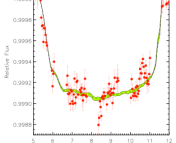Title: Impact of M-dwarf Stellar Wind and Photoevaporation on the Atmospheric Evolution of Small Planets
Authors: Ashini Modi, Raissa Estrela, Adriana Valio
First Author’s Institution: Harvard University
Status: Published in MNRAS. Available on arXiv.
Most of the exoplanets we have discovered to date orbit around the most common type of star in our universe – M-dwarfs. M-dwarfs are stars that are cool ( T < 3900 K compared to about 6,000 K for the Sun), small in size and not too massive, with a maximum mass of about 60% that of the Sun. These characteristics make it easier to find planets around these stars, in particular using the transit method, because more light from an M-dwarf is blocked by a planet passing in front than a planet of the same size passing in front of a Sun-like star.
Using the transit method, astronomers have found thousands of planets around M-dwarfs, with some of them orbiting really close to the star and some in the habitable zone (HZ) of the star. That’s great, right? After all, finding planets in the HZ could be a pathway to finding planets that could harbor life around other stars. However, there’s a problem (isn’t there always??)… M-dwarfs are extremely active stars, having lots of flares and emitting lots of UV rays that are generally known to be harmful for life to evolve. As it turns out, the activity is more intense during the young ages of a star. Stellar activity during the first hundred million years is so intense, in fact, that it is possible for the star to evaporate the atmosphere of a planet orbiting around it.
Today’s paper focuses on analyzing the impact of M-dwarf activity – in the form of increased X-ray to ultraviolet (XUV) radiation and stellar wind strength – on the atmosphere of exoplanets. They achieve this by using models on how stellar activity and photoevaporative mass loss (where the planet’s atmosphere is heated by the high energy radiation coming in from the host star and blows away) evolves over time. In order to make this more compatible with observations, they apply these models to the atmospheres of 34 discovered exoplanets in the HZ of their host star and 4 planets that are close-in (< 0.1 AU) to their host star. Out of these planets, 8 of them have Hubble Space Telescope transmission spectroscopy data, which allows for the measurement of the planet’s atmosphere. All of the planets in the sample are terrestrial and span sizes slightly larger than Earth to a little smaller than Neptune.
The authors use their simulations based on photoevaporation and stellar wind models to compute the atmospheric mass loss, planetary mass and planet radius as a function of time. In order to do that, they must take into account stellar properties such as wind velocity and density for stellar wind, and transform those varying properties into an equation for mass loss rate for the planet due to erosion. Figure 1 shows an example of the luminosity, wind velocity and wind density as a function of time for a specific case, GJ 1132. The luminosity function is based on observations, however, stellar wind properties are not observationally constrained yet, so the authors use observations for the Sun to model solar wind in the interplanetary space. For photoevaporation, they calculate how the X-ray to extreme ultraviolet (XUV) radiation of the star can affect atmospheric stability by ionizing the hydrogen atoms in the planet’s atmosphere, and thus adding energy to the system. They then translate this radiation to a mass loss equation for the planet. They also specify a “envelope loss threshold” for the planet, where, if the planet’s mass loss is large enough, then the planet most likely lost its primordial atmospheric envelope – gas that was gravitationally captured by the planet when it was still forming in a protoplanetary disk.
They do this calculation for all 38 planets in their sample, and find that most of the planets actually lose most of their mass due to photoevaporation. They also found that most planets lose their atmosphere in the first 2 Gyr out of the total 5 Gyr in the simulation, showing that this process is more efficient when the star is younger and more active. Figure 2 shows this trend for two specific examples: GJ 1214 b and Trappist-1 e, where in both cases the planet loses a total atmospheric mass above the threshold mainly due to photoevaporation.
Finally, the authors plot the planet’s “fractional envelope lost” as a function of planet orbital radius in AU (as a reminder, the Earth is 1 AU away from the Sun!). They show this both for stellar wind and for photoevaporation (Figure 3). Many of these planets could have significant portions – between 1 and 10 percent – of their atmospheres stripped away due to the star.
Overall, this work shows that a key driver of atmospheric mass loss in close-in planets is not stellar wind, but rather photoevaporation. Also, it shows that the planets at > 0.1 AU from their stars do not lose as much atmosphere as the < 0.1 AU planets: the median mass loss for > 0.1 AU planets is 0% and 1.7% for stellar wind and photoevaporation respectively, while for planets at < 0.1 AU the mass loss median due to photoevaporation was 100%! In their conclusion, the authors state that more observations on the evolution of M-dwarf stars’ activity and atmospheres are needed to better constrain the models on how the star’s activity impacts its host planets.
Astrobite edited by Keighley Rockcliffe
Featured image credit: NASA, ESA and D. Player (STScI)




